Fluid Filter
Item Name Code (INC) 32622
 |
A filter having inlet and outlet connections and designed to be connected in a pipe, tube or hose line. For spin-on, base-mounted filtering devices with integral outer casings, see FILTER ELEMENT, FLUID. Excludes AIR CONDITIONER.
 Additional Information for Fluid Filter
Additional Information for Fluid Filter
Fluid filters are devices used to remove impurities and contaminants from fluids, such as liquids or gases. They are commonly used in various industries, including automotive, manufacturing, oil and gas, and pharmaceuticals.
The main purpose of fluid filters is to ensure the cleanliness and quality of the fluid being used in a system or process. They help prevent damage to equipment, improve efficiency, and maintain product quality.
Fluid filters work by trapping and removing particles, debris, and other contaminants from the fluid as it passes through the filter media. The filter media can be made of various materials, such as paper, fabric, or metal, and is designed to capture particles of a specific size.
There are different types of fluid filters available, including:
1. Air filters: These filters are used to remove dust, pollen, and other airborne particles from the air before it enters an engine or HVAC system.
2. Oil filters: These filters are used to remove contaminants from engine oil, hydraulic oil, or other lubricating fluids. They help prolong the life of the engine or machinery by preventing abrasive particles from circulating and causing damage.
3. Fuel filters: These filters are used to remove impurities and water from fuel before it reaches the engine. They help maintain proper fuel flow and combustion efficiency.
4. Water filters: These filters are used to remove sediment, chlorine, bacteria, and other impurities from water. They are commonly used in residential, commercial, and industrial settings to ensure clean and safe water for drinking, cooking, and other purposes.
It is important to regularly inspect and replace fluid filters according to the manufacturer's recommendations to ensure optimal performance and prevent system failures.
 Related Item Names for INC 32622 Fluid Filter
Related Item Names for INC 32622 Fluid Filter
 NATO Stock Numbers with Item Name 32622 Fluid Filter Page 2 of 37
NATO Stock Numbers with Item Name 32622 Fluid Filter Page 2 of 37
- JHP39-248
- RNCC: 5 | RNVC: 9 | DAC: 6
- LF9130-01
- RNCC: 3 | RNVC: 2 | DAC: 4
- F12-100-M2PA
- RNCC: C | RNVC: 1 | DAC: 6
- MILF5504
- RNCC: 4 | RNVC: 1 | DAC: E
- 7W-2326
- RNCC: 5 | RNVC: 2 | DAC: 4
- 5705300
- RNCC: 3 | RNVC: 2 | DAC: D
- 2162003-101
- RNCC: 3 | RNVC: 2 | DAC: 5
- 2633-720-01 ASSY 54
- RNCC: 5 | RNVC: 2 | DAC: D
- ND9621 REV A SHEET 1
- RNCC: D | RNVC: 9 | DAC: B
- A4731800909
- RNCC: 3 | RNVC: 2 | DAC: 3
- HL3531PC9
- RNCC: 5 | RNVC: 9 | DAC: 5
- 12357-9
- RNCC: 5 | RNVC: 1 | DAC: F
- 286897-006
- RNCC: 3 | RNVC: 2 | DAC: 4
- 114299-35110
- RNCC: 5 | RNVC: 2 | DAC: 5
- 78002
- RNCC: 3 | RNVC: 2 | DAC: 4
- 84196445
- RNCC: 3 | RNVC: 2 | DAC: 3
- 188231PC531
- RNCC: 5 | RNVC: 2 | DAC: 5
- PFC-36
- RNCC: 3 | RNVC: 2 | DAC: 6